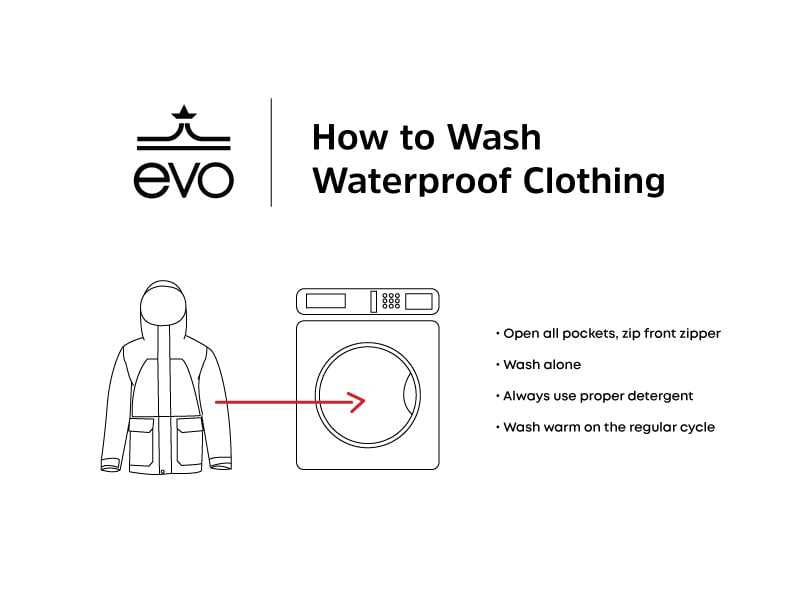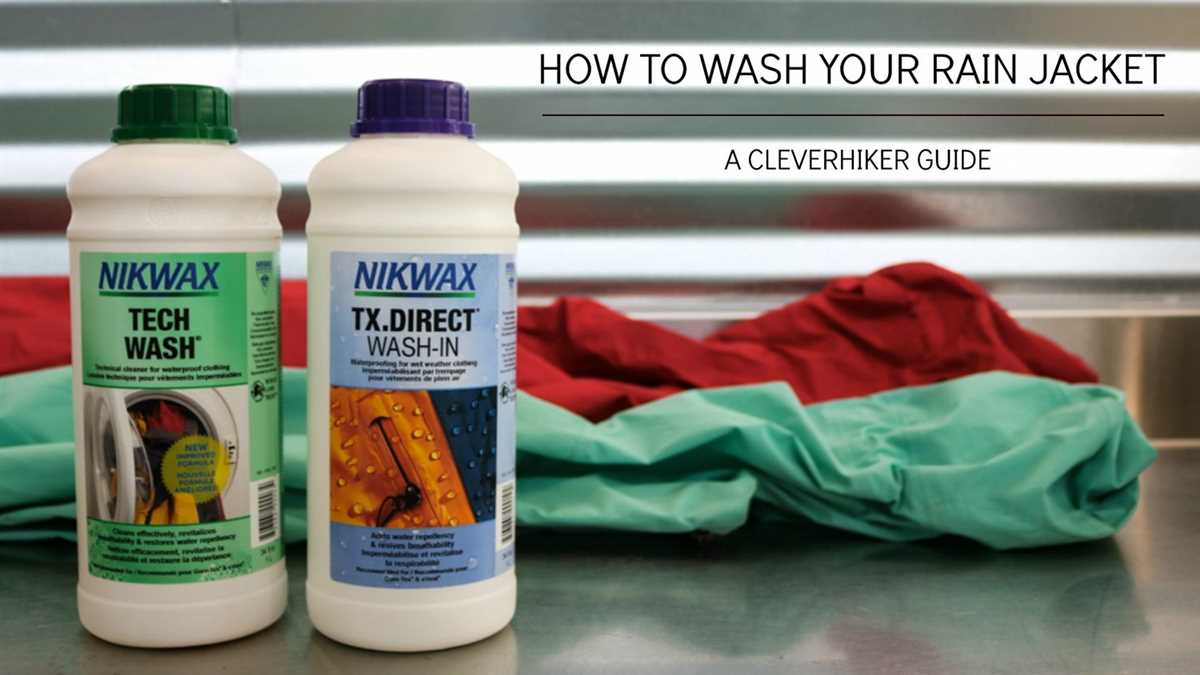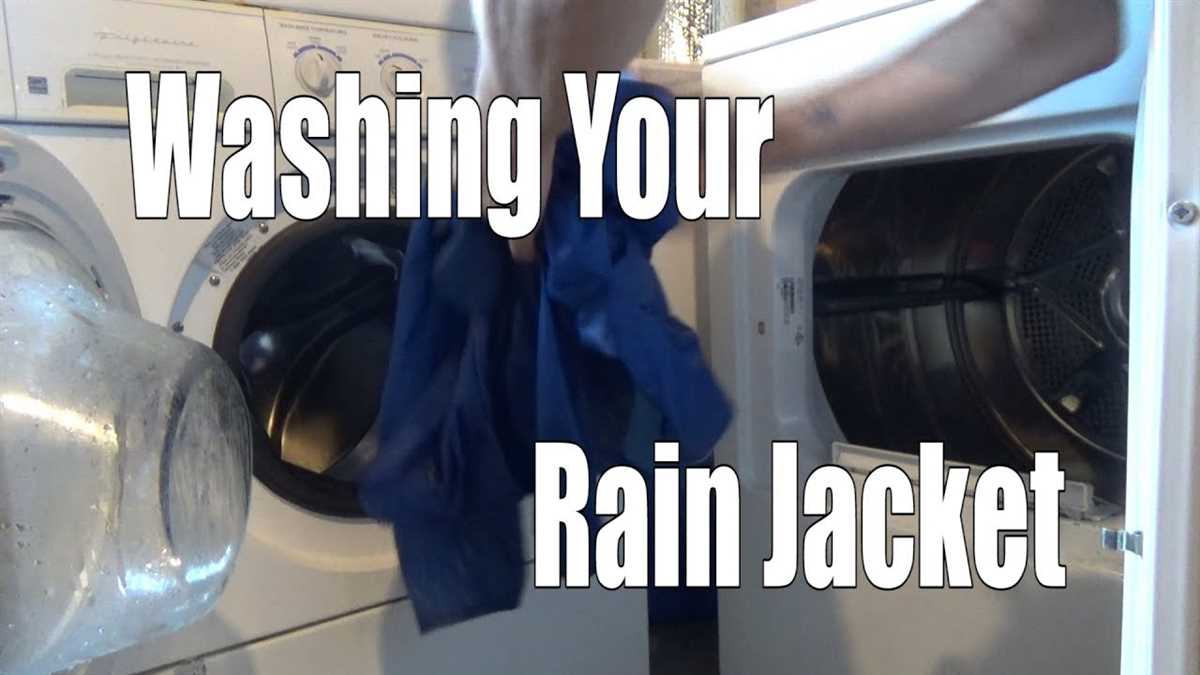




Rain jackets are a staple clothing item for anyone who lives in a wet climate or enjoys outdoor activities. However, constant exposure to rain and dirt can leave these jackets dirty and in need of a good cleaning. Many people wonder if it is safe to clean a rain jacket in the washing machine, or if it will damage the fabric or the waterproofing. In this article, we will explore whether or not it is safe to clean a rain jacket in the washing machine and provide some helpful tips for doing so.
Firstly, it is important to check the care label on your rain jacket before attempting to clean it in the washing machine. The care label will provide specific instructions for cleaning the jacket and may advise against machine washing. If the care label states that the jacket should be hand-washed, it is best to follow those instructions to avoid damaging the fabric or the waterproof coating.
However, if the care label does not explicitly prohibit machine washing, it is generally safe to clean a rain jacket in the washing machine. Before washing, it is recommended to close all zippers and Velcro, and turn the jacket inside out. This will help protect the outer fabric and prevent any small parts from getting caught or damaged during the wash cycle. It is also important to use a gentle cycle and cold water to minimize the risk of shrinkage or damage to the fabric.
If your rain jacket has a waterproof coating, it is important to note that machine washing may reduce the effectiveness of this coating over time. To help restore the waterproofing after washing, you can apply a waterproofing spray or wash-in waterproofing treatment. These products can be found at outdoor or sporting goods stores and can help maintain the jacket’s water repellency.
In conclusion, cleaning a rain jacket in the washing machine can be safe if done properly and if the care label does not advise against it. However, it is always a good idea to check the care label and follow any specific instructions provided by the manufacturer. By taking the necessary precautions, you can keep your rain jacket clean and in good condition, ready for your next outdoor adventure.
Can You Safely Clean a Rain Jacket in the Washing Machine?

Introduction:
A rain jacket is an essential piece of outdoor gear that helps keep you dry during wet weather conditions. However, over time, dirt, sweat, and oils can build up on the jacket, leading to a decrease in its water-repellent properties. Cleaning your rain jacket is important to maintain its performance and prolong its lifespan.
Can you clean a rain jacket in the washing machine?

Yes, you can clean a rain jacket in the washing machine, but it’s important to follow the manufacturer’s instructions and take certain precautions to avoid damaging the jacket or compromising its waterproofing abilities. Here are some steps to safely clean a rain jacket in a washing machine:
- Read the care label: Before washing your rain jacket, carefully read the care instructions provided by the manufacturer. This will ensure that you follow the recommended cleaning method and avoid any potential damage.
- Pre-treat stains: If your rain jacket has any stains, pre-treat them before washing. Follow the instructions on the stain remover product and gently rub it onto the stained area.
- Close all zippers and fasteners: Before placing your rain jacket in the washing machine, make sure to close all zippers, Velcro fasteners, and other closures to prevent them from snagging or damaging the fabric.
- Choose a gentle cycle: Select a gentle or delicate cycle on your washing machine. Use cold water and mild detergent specifically designed for technical garments or waterproof materials.
- Avoid fabric softeners: Fabric softeners can leave a residue on the rain jacket, reducing its waterproof properties. Avoid using fabric softeners during the washing process.
- Air dry the jacket: Once the washing cycle is complete, remove the rain jacket from the machine and hang it to air dry. Avoid using a dryer, as the high heat can damage the fabric or cause shrinkage.
Additional Tips:
- Reapply DWR treatment: Over time, the durable water repellent (DWR) coating on your rain jacket may wear off. After cleaning, consider reapplying a DWR treatment to restore the jacket’s water-repellent capabilities. Follow the manufacturer’s instructions or consult a professional for the best results.
- Use a front-loading machine: If possible, use a front-loading washing machine instead of a top-loading one. This is because top-loading machines with agitators can be more aggressive on delicate fabrics, potentially causing damage to your rain jacket.
- Spot clean when possible: If your rain jacket is only lightly soiled, spot cleaning with a damp cloth or sponge may be sufficient. This can help minimize the frequency of machine washing, reducing wear and tear on the jacket.
Conclusion:
Cleaning your rain jacket in the washing machine is possible, but it’s crucial to follow the care instructions provided by the manufacturer. Take precautions such as using a gentle cycle, mild detergent, and avoiding fabric softeners to keep your rain jacket in optimal condition. Regular cleaning and maintenance will help preserve its water-repellent properties and extend its lifespan, ensuring that you stay dry and comfortable during wet outdoor adventures.
The Importance of Proper Cleaning

Proper cleaning of a rain jacket is essential for maintaining its performance and durability. Regular washing not only removes dirt and stains but also helps restore the water-repellent finish of the fabric, ensuring that it remains waterproof.
1. Maintain Waterproofing: Over time, the water-repellent coating on a rain jacket can wear off due to exposure to dirt, sweat, oils, and other contaminants. By washing the jacket regularly, you can remove these substances and restore the fabric’s ability to repel water.
2. Prolong Lifespan: Keeping your rain jacket clean can help extend its lifespan. Dirt and grime can accumulate on the fabric, causing it to wear out faster. By regularly cleaning your jacket, you can prevent this build-up and ensure that it remains in good condition for longer.
3. Remove Odors: Rain jackets can develop unpleasant odors over time, especially if they are not cleaned regularly. Washing your jacket will remove these odors and keep it smelling fresh.
4. Enhance Performance: Proper cleaning can help maintain the breathability and performance of a rain jacket. Dirt and oils can clog the fabric’s pores, reducing its ability to release moisture and causing you to feel clammy and uncomfortable. Regular washing helps prevent this and ensures that the jacket performs at its best.
5. Preserves Appearance: Keeping your rain jacket clean and free from stains helps preserve its appearance. Stains can penetrate the fabric and be challenging to remove if left untreated for too long. Regular cleaning prevents these stains from becoming permanent and keeps your jacket looking fresh and presentable.
6. Avoid Cross-Contamination: Washing your rain jacket separately from other clothes helps prevent cross-contamination. This is particularly important if your jacket has been exposed to dirt, mud, or other substances that may transfer onto other garments in the wash.
Overall, properly cleaning a rain jacket not only improves its appearance but also ensures its longevity and performance. Regular washing helps maintain its water-repellent properties, prolong its lifespan, remove odors, enhance its performance, preserve its appearance, and prevent cross-contamination. Follow the manufacturer’s instructions for cleaning, and your rain jacket will continue to provide reliable protection against the rain for years to come.
Understanding the Material of Your Rain Jacket
A rain jacket is a crucial piece of outdoor apparel that keeps you dry in wet weather conditions. However, not all rain jackets are made the same way. It’s essential to understand the material of your rain jacket to know how to properly clean and care for it. Here are some common materials used in rain jackets:
- Nylon: Nylon is a lightweight and durable material commonly used in rain jackets. It offers good waterproofing and breathability, making it a popular choice among outdoor enthusiasts.
- Polyester: Polyester is another common material found in rain jackets. It is known for its ability to repel water and withstand harsh weather conditions. Polyester jackets are usually more affordable than nylon jackets.
- Gore-Tex: Gore-Tex is a high-performance material that offers excellent waterproofing and breathability. It is often used in premium rain jackets designed for extreme weather conditions.
- PU (Polyurethane) Coating: Some rain jackets have a PU coating on the outer layer, which enhances waterproofing. PU-coated jackets are often less breathable than jackets made with Gore-Tex or other technical fabrics.
It’s important to check the label or product description of your rain jacket to determine the specific material used. This information will help you understand the jacket’s properties and any special care instructions.
Proper Care for Different Rain Jacket Materials
Each rain jacket material requires different care to ensure its longevity and performance. Here are some general care tips:
- Follow the manufacturer’s instructions: Always refer to the care instructions provided by the manufacturer for your rain jacket.
- Machine wash or hand wash: Some rain jackets can be safely machine washed, while others may require hand washing. Check the care instructions to determine the appropriate method.
- Use gentle detergents: When washing your rain jacket, choose a mild detergent specifically designed for technical fabrics.
- Avoid fabric softeners: Fabric softeners can clog the pores of waterproof materials, reducing their effectiveness. Avoid using fabric softeners when washing your rain jacket.
- Hang to dry: After washing, hang your rain jacket to dry in a well-ventilated area. Avoid direct sunlight, as it can damage the material.
Remember, proper care and maintenance of your rain jacket will ensure its longevity and effectiveness in keeping you dry during rainy adventures.
Preparation for Machine Washing
Before you start cleaning your rain jacket in the washing machine, it’s important to properly prepare the jacket and the washing machine. Follow these steps:
- Read the care instructions: Check the label on your rain jacket for specific cleaning instructions. Some jackets may require special treatment or recommend against machine washing.
- Empty the pockets: Remove any items from the pockets of your rain jacket. This includes keys, coins, and any other items that could cause damage to the jacket or the washing machine.
- Close all zippers and fasteners: Zip up all zippers and close any Velcro or snap fasteners on your jacket. This will help protect the jacket and prevent it from getting caught on other items in the washing machine.
- Turn the jacket inside out: Turning the jacket inside out will help protect the outer layer of your rain jacket during the wash cycle. It will also allow the detergent and water to better penetrate the fabric.
- Check for stains: Take a close look at your rain jacket and identify any stains or spots. Pre-treat them with a stain remover or a mild detergent before putting the jacket in the washing machine.
- Remove any detachable items: If your rain jacket has a removable hood or any other detachable parts, take them off before putting the jacket in the washing machine. This will prevent them from getting damaged or causing damage during the wash cycle.
- Choose a gentle cycle: Select a gentle or delicate cycle on your washing machine. This will help protect the fabric and maintain the waterproof coating on your rain jacket.
- Use a mild detergent: Avoid using harsh detergents or fabric softeners, as they can strip the waterproof coating from your rain jacket. Instead, use a mild detergent specifically designed for outdoor gear or a gentle, non-bio detergent.
By properly preparing your rain jacket and the washing machine, you’ll be able to safely and effectively clean your rain jacket in the machine.
Machine Washing Your Rain Jacket

Machine washing your rain jacket is a convenient and effective way to keep it clean and maintain its waterproofing abilities. However, it’s important to follow the proper steps and precautions to ensure that your rain jacket stays in good condition. Here’s a step-by-step guide on how to safely clean your rain jacket in the washing machine:
Check the Label

Before washing your rain jacket, check the label or the manufacturer’s instructions to see if it is safe to machine wash. Some rain jackets are designed to be machine washable, while others may require special care or professional cleaning.
Prep Your Rain Jacket

Before placing your rain jacket in the washing machine, make sure to empty all the pockets and zip up all the zippers. This will help prevent any small items from getting lost or damaged during the washing process.
Use a Mild Detergent
When washing your rain jacket, it’s important to use a mild detergent that is specifically designed for waterproof or technical fabrics. Avoid using harsh detergents, fabric softeners, or bleach as these can damage the waterproof coating of your jacket.
Set the Washing Machine
Set your washing machine to a gentle cycle with cold water. High temperatures can damage the waterproof coating, so it’s important to use cold water. Avoid using the spin cycle as this can also damage the jacket.
Wash Alone or with Similar Garments
It’s best to wash your rain jacket alone or with other similar waterproof or technical garments. Avoid washing it with heavy items like jeans or towels as they can cause friction and potentially damage the fabric.
Hang to Dry
After the washing cycle is complete, remove your rain jacket from the washing machine and hang it up to dry. Avoid using a dryer as high heat can damage the fabric and the waterproof coating. Instead, let your rain jacket air dry naturally.
Reapply DWR if Needed
Over time, the Durable Water Repellent (DWR) coating on your rain jacket may wear off. If you notice that water is no longer beading on the surface of your jacket, you can reapply a DWR treatment. Follow the manufacturer’s instructions for the specific product you are using.
By following these steps, you can safely clean your rain jacket in the washing machine and keep it looking and performing its best for a long time.
Drying and Maintenance Tips
Air Drying
After washing your rain jacket, it is important to let it air dry. Hang it up or lay it flat in a well-ventilated area, away from direct sunlight and heat sources. Avoid using a clothes dryer, as the high heat can damage the waterproof coating of the jacket.
Removing Excess Water
Prior to air drying, gently squeeze out any excess water from the rain jacket. Do not wring or twist the fabric, as this can cause damage or stretching. Use a clean towel to pat and absorb the moisture, focusing on areas like cuffs and hems.
Storage
Proper storage is important to maintain the quality of your rain jacket. Make sure it is completely dry before storing it, as any moisture can lead to mildew or mold growth. Fold the jacket neatly and store it in a cool, dry place. Avoid storing it in a damp or humid environment, such as a basement or garage.
Cleaning Frequency
How often you wash your rain jacket will depend on how frequently you use it and the level of dirt and stains it accumulates. As a general guideline, it is recommended to wash your rain jacket every 10-15 uses or when it starts to lose its water-repellent properties. However, always check the care instructions provided by the manufacturer for specific recommendations.
Additional Tips

- Avoid using fabric softeners or bleach when washing your rain jacket, as they can degrade the waterproof coating.
- If your rain jacket has a removable hood, make sure to detach it before washing.
- Inspect your rain jacket regularly for any signs of damage or wear. If you notice any tears or loose seams, repair them promptly to prevent further damage.
- If your rain jacket has a DWR (Durable Water Repellent) coating, you can restore its water-repellent properties by applying a waterproofing spray or wash-in product. Follow the instructions provided by the manufacturer for best results.
By following these drying and maintenance tips, you can ensure the longevity and performance of your rain jacket for years to come.
FAQ
Can I wash my rain jacket in the washing machine?
Yes, you can wash your rain jacket in the washing machine. However, you need to follow some specific instructions to ensure it is cleaned safely.
What type of detergent should I use to wash my rain jacket?
It is recommended to use a mild detergent when washing your rain jacket in the washing machine. Avoid using harsh chemicals or bleach as they can damage the waterproof coating.
Should I use hot or cold water when washing my rain jacket?
It is best to use cold water when washing your rain jacket in the washing machine. Hot water can affect the waterproof coating and cause it to degrade over time.
Can I put my rain jacket in the dryer after washing it?
No, it is not recommended to put your rain jacket in the dryer after washing it. The heat from the dryer can damage the waterproof coating. Instead, hang it up to air dry in a well-ventilated area.
Is it necessary to reapply a waterproof coating after washing my rain jacket?
It depends on the type of rain jacket you have. Some rain jackets have a durable water repellent (DWR) coating that may need to be reapplied after washing. Check the care instructions or contact the manufacturer to determine if reapplying the waterproof coating is necessary.
Is it safe to wash a rain jacket in the washing machine?
Yes, it is generally safe to wash a rain jacket in the washing machine. However, it is important to check the care instructions on the label of your rain jacket to make sure it can be machine washed. Some rain jackets require special care and may need to be hand washed or dry cleaned.
What is the best way to clean a rain jacket?
The best way to clean a rain jacket is to follow the care instructions provided by the manufacturer. In general, most rain jackets can be safely machine washed on a gentle cycle with a mild detergent. It is recommended to zip up all the zippers, close any Velcro fastenings, and remove any detachable components, such as a hood or liner, before washing. After washing, hang the jacket to air dry or use a low heat setting in the dryer if allowed by the care instructions.












